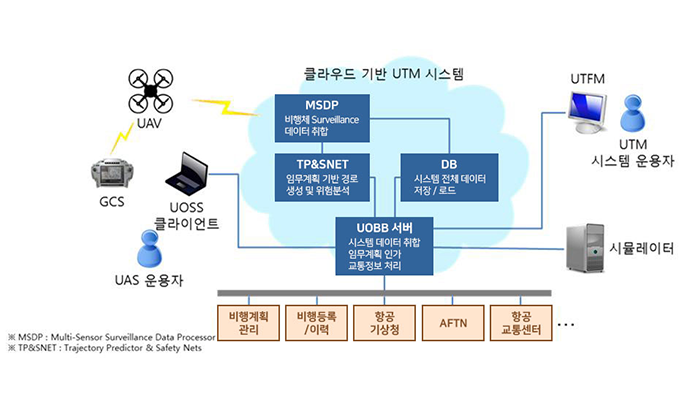

Providing Air Traffic Services for Drones for Enhancing Safety and Utilization of Manned and Unmanned Aircraft
As drone technology advances, their use in civilian and public sectors is rapidly expanding, resulting in a sharp increase in flight demand. Ensuring safety between drones, between drones and manned aircraft, and between drones and people on the ground has emerged as a critical technical and regulatory challenge. Consequently, research on drone traffic management systems (UTM), designed to minimize risks to manned aviation and maximize UAV operational efficiency, began in the United States and has since spread to Europe (U-space) and other countries.
The Drone Traffic Management System (UTM) is designed to support safe and efficient operations of UAVs under 150 kg in mass operating at altitudes below 150 meters. From 2017 to 2022, KARI participated in a project funded by the Ministry of Land, Infrastructure, and Transport to develop and demonstrate a UTM prototype system, validating its functionality and feasibility. KARI is currently participating in the second phase of UTM development, which is planned for 2023 to 2026. This phase aims to establish a decentralized architecture comprising the national Flight Information Management System (FIMS) and the UTM Service System (USS), which will involve both public and private service providers. In parallel, technical development and legal/regulatory reforms are underway to support commercialization. Technically, the second phase of UTM focuses on establishing interoperability between multiple USS providers in Korea's UTM-designated airspace and ensuring a seamless information exchange with FIMS. It also includes the development of a national UTM Concept of Operations (CONOPS) and corresponding legislation, technical standards, and institutional frameworks to facilitate commercialization.
Managing Over 300 Drones Simultaneously in a Single USS Service Region
In the initial phase, KARI developed a UTM traffic management system capable of supporting more than 100 drones flying beyond visual line of sight (BVLOS) simultaneously from a centralized control center. In the ongoing second phase, the focus is on scaling the system to a nationwide USS network and enhancing its integration with other traffic management systems. The prototype currently under development is designed to enable a single USS to handle over 300 drones simultaneously within the UTM-designated airspace, providing real-time traffic management services. Once commercialized, both hardware and software will be further scaled to flexibly handle the anticipated drone traffic demand.
Since the UTM system utilizes high-speed mobile communication and Internet networks, drone operators can easily monitor their drone’s ID, location, and actual flight trajectory in real-time using mobile devices from virtually anywhere. In the long term, flight plan approvals and special flight permissions currently handled via the Drone One-Stop Civil Service Portal are expected to be integrated into the UTM system. The UTM system will provide real-time data on nearby drones, no-fly zones, weather conditions within the airspace, and manned aircraft activity— including real-time tracking of other drones in flight nearby—capabilities not currently supported by the Drone One-Stop Civil Service Portal. This will significantly enhance UAV operational safety and utility by preventing collisions, alerting operators to potential airspace violations, and issuing automated warnings. Moreover, the UTM will serve as a core tool for government agencies and air traffic control authorities to monitor and intercept unauthorized drones and mitigate the risk of collisions between manned and unmanned aircraft. Additionally, UTM technology is expected to serve as foundational infrastructure not only for drones and other UAVs but also for ensuring the navigational safety of personal air vehicles in future Urban Air Mobility (UAM) environments.
